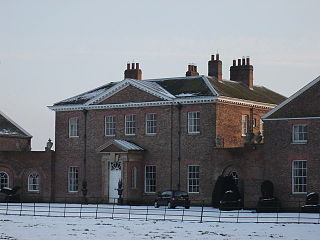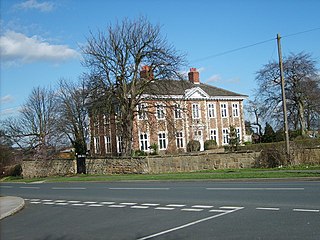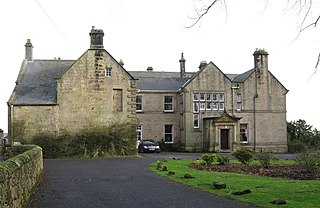
Bretton Hall is a country house in West Bretton near Wakefield, West Yorkshire, England. It housed Bretton Hall College from 1949 until 2001 and was a campus of the University of Leeds (2001–2007). It is a Grade II* listed building.

Croxteth Hall in West Derby, Liverpool, is the former country estate and ancestral home of the Molyneux family, the Earls of Sefton. After the death of the 7th and last Earl in 1972, the estate passed to Liverpool City Council, which now manages the remainder of the estate, following the sale of approximately half of the grounds. The remaining grounds, Croxteth Park, were at one time a hunting chase of the Molyneux family and are now open to the public. The hall is recorded in the National Heritage List for England as a designated Grade II* listed building.

Houghton Hall, Sancton, near Market Weighton, is a Grade I listed Georgian country mansion in the East Riding of Yorkshire, England, set in an estate of 7,800 acres (32 km2). Located on the estate is the village of Sancton and the vestigial remains of the ancient hamlet of Houghton. It was built c. 1765–8 by Philip Langdale to the designs of Thomas Atkinson and underwent minor remodelling in 1960 by Francis Johnson. It is built in pink brick with stone dressing and slate roof, with a three-storey, 5-bay main block.

Austhorpe Hall is a house built in 1694 at Austhorpe, Leeds, West Yorkshire, England. It is a grade II* listed building.

Embleton Hall was a country manor house and then a now a hotel in the small ex-mining village of Longframlington, Northumberland, England. It is a Grade II listed building.

Hallfield House is a Grade II listed building situated in Bradfield Dale, 1.7 miles (2.74 km) west of the village of Low Bradfield, near Sheffield in England.

Peel Hall is a country house near the village of Ashton Hayes, Cheshire, England. It is recorded in the National Heritage List for England as a designated Grade II* listed building. It was built as a mansion in 1637, but was much reduced in size by 1812, and was later used as a farmhouse. It is constructed in sandstone and has slate roofs. Its architectural style is Jacobean.
Christleton Old Hall is a former country house in the village of Christleton, Cheshire, England.

Hassall Hall is a former manor house to the east of the village of Hassall, Cheshire, England. The house dates from the 17th century, and was re-fronted in the 19th century. It has since been divided into two houses. It is constructed in rendered brick and has a slate roof. The house has an H-plan. The entrance front is symmetrical, in two storeys, with five bays. The central three bays are recessed and the middle bay contains a doorway. The doorway is flanked by Tuscan pillars, and above the door is an open pediment enclosing a fanlight. The houses are recorded in the National Heritage List for England as a designated Grade II* listed building.

Hulme Hall is a house on a moated site in the parish of Allostock, Cheshire, England. It originated in the 15th century, with additions and alterations in the 17th and 19th centuries. It is now a farmhouse. The house is constructed in brown brick, and has a roof of stone-slate and Welsh slate. It is in two storeys with an attic, and has an asymmetrical plan. The northeast front is the entrance front, and has three gabled bays. The garden front is on the northwest; it has five bays, two of which are stepped back in two stages. Most of the windows are two or three-light casements. The house is recorded in the National Heritage List for England as a designated Grade II* listed building. The bridge over the moat leading to the house is also listed at Grade II*. The moated site on which the house stands is a scheduled monument. It had been the home of the Grosvenor and Shakerley families, both of whom were prominent in Cheshire.
Ingersley Hall, later Savio House, stands to the east of the town of Bollington, Cheshire, England. The house was built in about 1775 for John Gaskell. Extensions were added to it in 1833 for John Upton Gaskell. The house was sold by the Gaskell family in 1933. In the 1950s it was taken over by a religious order, the Salesians of Don Bosco, and renamed Savio House. As of 2011 the house is used as a retreat and activities centre for young people. The front of the house is constructed in ashlar, with the remainder in coursed sandstone rubble. The house is roofed in Welsh slate and has stone chimneys. It has a rectangular plan and is in two storeys. The architectural style is Greek Revival. The north front is symmetrical with five bays divided by pilasters. The porch is in Doric style. The west front has eight bays, the central three of which were in the original house. All the windows in the north and west fronts are sashes with 12 panes. The south door is in Tuscan style, and was probably moved from the west front. The house is recorded in the National Heritage List for England as a designated Grade II listed building. Also listed at Grade II is a former coach house to the south of the hall, built in about 1850, and converted into a conference hall in about 1950.

Ollerton Hall is a country house in the village of Ollerton, Cheshire, England. Its nucleus dates from the 17th century, originally on an H-plan, followed by a succession of "rambling extensions". A plaque over the entrance is inscribed with the initials THP" and the date 1728. The house was built originally for the De Baguley family. The building is constructed in rendered brick with a slate roof. It is in two storeys and, with the later extensions, has an E-plan. The entrance front has five bays, the central bay projecting forward with a gable. At each end is a gabled cross wing. The windows are a mixture of sashes and casements. The house is recorded in the National Heritage List for England as a designated Grade II listed building.

Ravenscroft Hall is a country house standing to the east of the B5309 road about 1 mile (1.6 km) to the north of Middlewich, Cheshire, England. The house was built in 1837 for William T. Buchanan, replacing a former Jacobean house. It was extended, possibly in 1852 when the house was bought by the Moss family, and again in 1877. The house has since been divided into two dwellings. It is constructed in roughcast and yellow brick, with stone dressings and slate roofs. The house is in two storeys, with a main front of five bays, and a five-bay extension to the northeast. The garden front also has five bays. The house has an Ionic porch, and an Italianate belvedere. It is recorded in the National Heritage List for England as a designated Grade II listed building.
Tattenhall Hall is a country house standing to the south of the village of Tattenhall, Cheshire, England. The house is designated by English Heritage as a Grade II* listed building.

Stumperlowe Hall is a small English country house situated in the City of Sheffield, England. It is located on Stumperlowe Hall Road at its junction with Slayleigh Lane in the suburb of Fulwood. The hall is a Grade II listed building.

Holme Hall is a grade II* listed 18th-century country house in Holme-on-Spalding-Moor, East Riding of Yorkshire, England. It was then a Sue Ryder Care Home until its closure in February 2018.

Dalton Hall is a grade II* listed Georgian country house in Dalton Holme, East Riding of Yorkshire, England.

Moseley Hall is a Grade II listed 18th-century country house which was situated in parkland in Moseley, Birmingham. The hall itself is now part of Moseley Hall Hospital and much of the surrounding estate has been developed for roads and housing.

Heathcote is a Neoclassical style villa in Ilkley, West Yorkshire, England. Designed by architect Edwin Lutyens, it was his first comprehensive use of that style, making it the precursor of his later public buildings in Edwardian Baroque style and those of New Delhi. It was completed in 1908.

Hitchin Priory in Hitchin in Hertfordshire is today a hotel built in about 1700 on the site of a Carmelite friary founded in 1317, which was closed in the Dissolution of the Monasteries during the reign of Henry VIII. Parts of the original priory are incorporated in the existing building, which has been a Grade I listed building on the Register of Historic England since 1951.

















